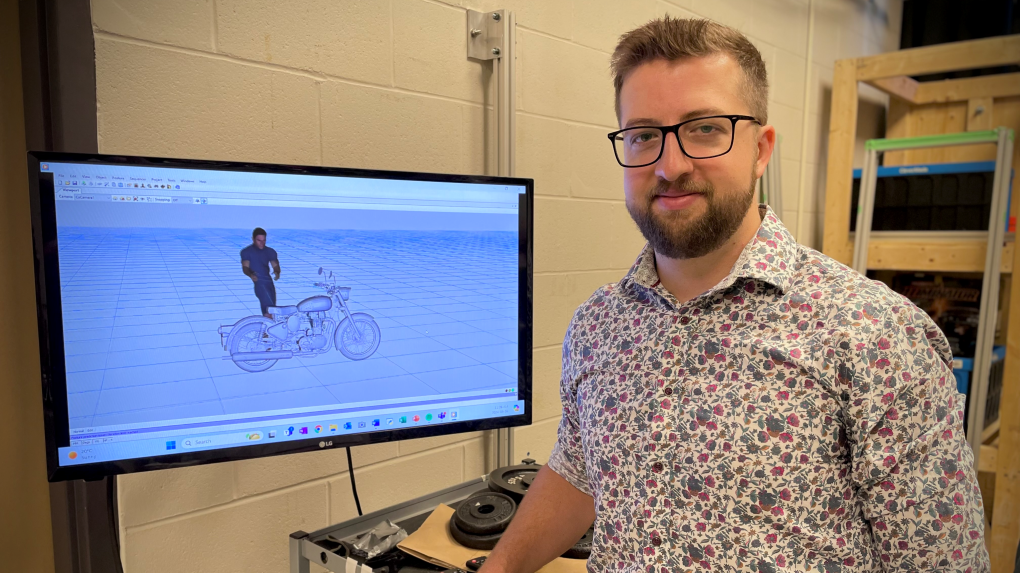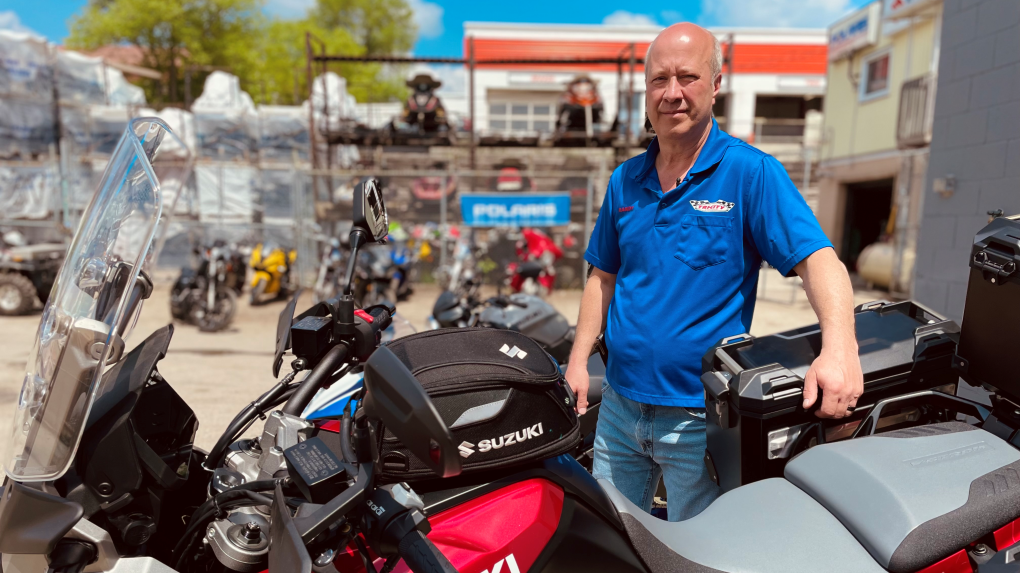University of Waterloo researchers aim to make motorcycles more comfortable
Researchers at the University of Waterloo are using software to predict how motorcycle riders will sit based on their height and body shape, in an effort to make the ride more comfortable.
The hope is that manufacturers can benefit from seeing how humans interact with designs before a bike is even built.
PhD candidate Justin Davidson has found motorcycles are generally designed to accommodate the average-sized rider, meaning taller and shorter riders are more likely to experience discomfort.
Taller riders are required to flex their ankles, knees, hips and elbows more to interact with the motorcycle properly, while shorter riders have fewer options in possible joint angle configurations, allowing them to reach the seat, handlebars and foot pegs simultaneously.
But with the help of a digital human model (DHM), researchers at UW’s Occupational Biomechanics Ergonomics Lab can create an avatar with certain height, weight or sex specifications that interacts with a motorcycle design and anticipates comfort levels.
 Justin Davidson at the University of Waterloo's Occupational Biomechanics Ergonomics Lab on May 16, 2024. (Spencer Turcotte/CTV Kitchener)
Justin Davidson at the University of Waterloo's Occupational Biomechanics Ergonomics Lab on May 16, 2024. (Spencer Turcotte/CTV Kitchener)
“This is the different postures and the way that you configure your joints to sit on them,” said Davidson. “We use that to drive some of the simulations that we did in the computer using digital human modelling software.”
With more than 40 years in the motorcycle industry, comfort is something that’s always top of mind for Tri-City Cycle & Sport president Randy Kuchma.
He has to be mindful of a customer's height when helping them decide which style of bike to buy.
“The problem is that every height is different. And how do you build a bike for every height?” Kuchma said.
 Randy Kuchma of Tri-City Cycle & Sport on May 16, 2024. (Spencer Turcotte/CTV Kitchener)
Randy Kuchma of Tri-City Cycle & Sport on May 16, 2024. (Spencer Turcotte/CTV Kitchener)
Years ago, comfort was an afterthought for manufacturers. Now, they’re often designed on a computer and adapted many times with more comfort in mind.
But Davidson and his team at UW want to add an extra step before anything is built.
The hope is this will allow for a thorough trial-and-error phase prior to anything being manufactured, leading to potential benefits for the companies creating the motorcycles.
“What that does is it saves money for the companies because they can do everything before building any physical prototypes. And it creates better designs long-term because they’ll have a better budget,” Davidson explained.
The idea isn’t to reinvent the wheel, but to use DHM tools to enhance the design process early on, making people safer and more comfortable in the long run.
CTVNews.ca Top Stories

At least 4 buildings burned at Jasper Park Lodge, others damaged: Fairmont memo
The Fairmont Jasper Park Lodge said Thursday afternoon most of its structures are "standing and intact," including its iconic main lodge.
Major Canadian bank dealing with direct deposit outage on pay day
Scotiabank has acknowledged technical difficulties affecting direct deposits as clients report missed payments Friday morning. On Friday morning, the bank's client services phone line was playing an automated message assuring customers that work was underway to rectify the outage.
Elon Musk's estranged daughter calls out his 'entirely fake' claims about her childhood
Vivian Jenna Wilson, Elon Musk's estranged daughter, publicly refuted several recent anti-trans statements her Tesla CEO and X owner father has made about her.
Reported rate of child pornography increased 52% in 2023, total crime up 3%: Statistics Canada
Last year, reported child pornography cases increased by more than 50 per cent in Canada, in part due to more cases being sent to police by specialized internet child exploitation units, according to a Statistics Canada report.
Sask. appeal court says anti-trans group cannot join constitutional dispute over pronoun law
Saskatchewan’s Court of Appeal has denied a political group that opposes so-called “gender ideology” intervener status in a legal dispute over the province’s controversial pronoun law.
Justin Timberlake's attorney disputes he was intoxicated when arrested for DWI
A hearing in the case of Justin Timberlake being accused of driving while intoxicated was held Friday, where an attorney for the singer disputed his arrest in June.
What we know about 'malicious' attack on French train network ahead of Olympics opening
French transport was thrust into chaos Friday just hours ahead of the Olympics 2024 opening ceremony after a series of co-ordinated 'malicious acts' upended high-speed train lines.Here's what happened and what we know so far.
When Barbie learned what a gynecologist was, so did many other people, according to new study
A new study published Thursday in the journal JAMA Network Open has found that the ending in the 2023 blockbuster film 'Barbie' had an influence on online search interest in terms around gynecology, the branch of medicine that deals with women’s reproductive health.
Canada Soccer head investigating 'systemic ethical shortcoming' amid spying scandal
Canada Soccer chief executive officer Kevin Blue said he was investigating a potential 'systemic ethical shortcoming' within the program but has not considered pulling the women's soccer team from the Paris Olympics due to a drone spying scandal.






























